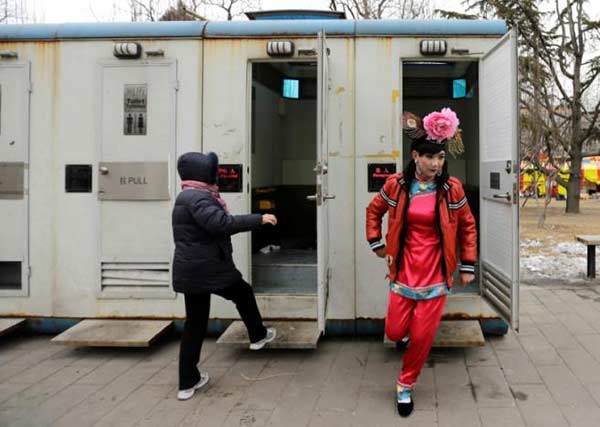China plans 'toilet revolution' to boost tourism
 |
|
A male folk artist (R) dressed as a traditional Chinese woman walks out of a mobile toilet ahead of a performance at a Spring Festival Temple Fair on the fifth day of the Chinese Lunar New Year at Longtan Park in Beijing, Feb 14, 2013. [Photo/Agencies] |
China said it will boost investment in tourism, with plans to develop rustbelt regions and upgrade public toilets high on its to-do list as it looks to lift the sector's contribution to economic growth.
Announcing a new plan for the sector, China said it aims to invest 2 trillion yuan ($290 billion) in tourism between 2016 and 2020 which would translate to annual growth of more than 14 percent in direct investment in the industry.
Old industrial and resource-dependent cities, particularly in the north of the country, will be encouraged to develop tourism and the government has promised to set up "demonstration tourist bases" in those areas. Several coal cities have already made efforts to turn defunct mines into parks.
The plan also promised a "toilet revolution", prompted by complaints about toilet hygiene levels at China's tourist spots and said the country would aim to build or renovate as many as 100,000 public toilets over the period.
The investment will help China's emerging tourism industry account for 12 percent of annual economic growth by 2020, up from 10.8 percent last year, the country's cabinet said.
The total sum of tourism services purchased by the country is set to reach 7 trillion yuan ($1 trillion) by 2020, equivalent to more than an 11 percent increase in tourism revenue per year, the State Council said.
The government predicted domestic travelers would take 6.4 billion trips annually by 2020, up from 4 billion in 2015, while the number of trips to China by overseas travelers is set to rise to 150 million, from 134 million last year.
China's state planner said this month that tourism investment targets will be met by attracting more private investment into the industry.









